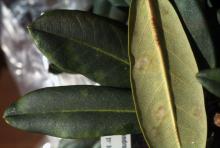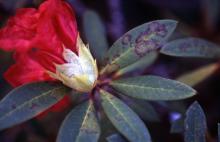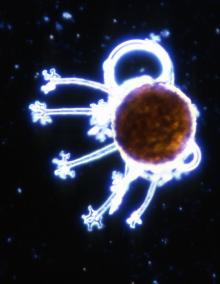Cause The fungus Erysiphe azaleae (formerly Microsphaera azaleae) is found throughout the Pacific Northwest on garden azalea and rhododendron species and hybrids. Molecular techniques have identified a similar looking fungus as E. digitata which may have been introduced into the PNW in the 1990's. Erysiphe vaccinii (formerly Microsphaera vaccinii) has been found on wild R. occidentale growing on the southern Oregon coast. Disease symptoms have not been found on the other Northwest native species, R. albi-florum and R. macrophyllum.
These fungi are obligate parasites that produce two kinds of spores. Asexual conidia are most frequent; they spread by wind and produce new colonies, which produce more spores. Many infection cycles may occur in a summer. The disease develops late in summer, but overwintering colonies have been seen throughout the winter on leaves' undersides. Sexual spores are produced in small, black, spherical structures (chasmothecia). They are produced in fall in great numbers on azalea but are less frequent on evergreen rhododendrons. High humidity and low light intensity favors the disease. During the 1990s, growers reported more severe powdery mildew on cultivars, such as Virginia Richards, that normally were not attacked.
Symptoms Symptoms appear to be influenced more by cultivar than by environment. The most common symptoms are diffuse pale yellow spots on the leaf upper surface, usually from 0.25 to 1 inch in diameter. On the lower leaf surface are purple to brown, circular, diffuse feathery areas. Sometimes, a sparse fungal growth is within the spots. Other symptoms on the upper leaf surface include large purple-brown spots, or purple-brown areas associated with veins, or purple ringspots, or occasionally green spots as the remainder of the leaf yellows. Some cultivars such as Unique show no symptoms on the top of the leaf but have typical diffuse colored spots or a heavy powdery growth on the leaf's underside.
Necrotic, brown, sunken spots are not associated with this disease; they are caused by a number of other fungal and environmental factors. Severe defoliation can occur on some cultivars such as Virginia Richards and species such as R. campylocarpum and R. cinnabarinum. As leaves begin to defoliate, usually in fall or early spring, they can have various patterns of yellow, red, and brown. Other cultivars can tolerate considerable leaf spotting without much defoliation. Most azaleas and some evergreen rhododendrons (such as 'Purple Splendor' and 'Vulcan's Flame') have the typical white powdery growth on both sides of the leaf usually associated with powdery mildew.
Cultural control
- Plant resistant hybrids or species.
- Remove infected plant parts if practical.
- The value of removing and destroying fallen leaves is not known. This practice may help only those plants that produce chasmothecia.
- Reduce relative humidity by adjusting irrigation practices and spacing plants for good air circulation.
- Avoid planting in heavily-shaded areas.
Chemical control Begin multiple applications when you first notice the disease on current-year leaves. Scouting and early detection aid overall control. Alternate or tank-mix products from different groups that have different modes of action. Limit the use of any one group during crop production.
- Armada 50 WDG at 3 to 9 oz/100 gal water. Do not use a silicone-based surfactant. Not for nursery or greenhouse use. Group 3 + 11 fungicide. 12-hr reentry.
- BioAdvanced Disease Control at 0.75 fl oz/gal water. H
- Bicarbonate-based products. Might supplement a normal program when powdery mildew is first observed. Do not mix with acidifying agents. Thorough coverage is essential. O
- MilStop SP (85% potassium bicarbonate) at 2.5 to 5 lb/A in the field or 1.25 to 5 lb/100 gal water in the greenhouse. Oregon and Washington only. 1-hr reentry.
- Monterey Bi-Carb Old Fashioned Fungicide at 4 teaspoons/2 gal water. H
- Broadform at 2 to 4 fl oz/100 gal water. Group 7 + 11 fungicide. 12-hr reentry.
- Eagle 20 EW at 6 to 12 fl oz/100 gal water. Group 3 fungicide. 24-hr reentry.
- Heritage at 1 to 4 oz/100 gal water plus a non-silicone-based wetter sticker. Group 11 fungicide. 4-hr reentry.
- Insignia SC at 3 to 6 fl oz/100 gal water. Do not use with organosilicate-based adjuvants. Use preventively only. Group 11 fungicide. 12-hr reentry.
- Monsoon Turf at 4 to 10 fl oz/100 gal water. Group 3 fungicide. 12-hr reentry.
- Myclobutanil 20 EW T&O at 6 to 12 fl oz/100 gal water plus spreading agent. May observe a PGR effect. Group 3 fungicide. 24-hr reentry.
- Ortho Rose & Flower Disease Control at 2 fl oz/gal water. Group 3 fungicide. H
- Pageant at 6 to 12 oz/100 gal water. Do not use with organosilicone-based adjuvants. Group 7 + 11 fungicide. 12-hr reentry.
- Propiconazole-based products are registered for other pests and may also be very effective against this one. Group 3 fungicides.
- Banner MAXX at 8 to 12 fl oz/100 gal water. 12-hr reentry.
- Safer Brand Garden Fungicide (Ready To Use 0.4% sulfur) thoroughly sprayed over the entire plant. Do not use when the temperature is over 85°F or within 4 weeks of an oil spray. H
- Seido at 4 to 5 fl oz/100 gal water plus an adjuvant. Group 50 fungicide. 4-hr reentry.
- Spectracide Immunox Multi-Purpose Fungicide Spray Concentrate for Gardens at 1 fl oz/gal water. Group 3 fungicide. H
- SuffOil-X at 1 to 2 gal/100 gal water. Do not use in conjunction with sulfur. Do not use when plants are under heat or moisture stress. 4-hr reentry.
- Tebuzol 3.6F at 4 to 10 fl oz/100 gal water. Group 3 fungicide. No reentry interval listed.
- Terraguard SC at 4 to 8 fl oz/100 gal water. Group 3 fungicide. 12-hr reentry.
- Torque at 4 to 10 fl oz/100 gal water. Group 3 fungicide. 12-hr reentry.
- Tourney EZ at 1 to 4 oz/100 gal water. Group 3 fungicide. 12-hr reentry.
- Trinity at 4 to 12 fl oz/100 gal water. Group 3 fungicide. 12-hr reentry.
Biological control
- Cease or Rhapsody (Bacillus subtilis strain QST 713) at 2 to 8 quarts/100 gal water. Active ingredient is a small protein. Efficacy in the Pacific Northwest is unknown. 4-hr reentry. O
Reference Kenyon, D.M., Dixon, G.R., and Helfer, S. 2002. Effects of relative humidity, light intensity and photoperiod on the colony development of Erysiphe sp. on rhododendron. Plant Pathology 51:103
Tymon, L.S., Bradshaw, M., Götz, M., Braun, U., Peever, T.L. and Edmonds, R.L. 2022. Phylogeny and taxonomy of Erysiphe spp. on Rhododendron, with a special emphasis on North American species. Mycologia. 114:887-899.






